Brockhouse - Wiggler High Energy Beamline
Overview
The Wiggler High Energy (WHE) beamline has a flexible end-station that can accommodate a wide range of experiments that benefit from the use of high energy X-rays. The beamline is able to access any energy between 20 and 94 keV, although in practice energies between 30-35 keV and 55-70 keV are typically used.
The high energy X-rays coming from the central portion of the wiggler radiation fan are reflected inboard by a bent single crystal Si monochromator in Laue mode using either the (111), (422), or (533) reflections, depending on the energy that is being selected. The crystal provides an excellent vertical focus of around 50 µm. The beam size is reduced horizontally using slits. The typical horizontal size is about 200 µm, although this can be made larger or smaller depending on if resolution or flux is more important for the application. The flux ranges between 1 × 1010 to 2 × 1013 photons/second depending on the energy. This beamline uses one of two area detectors mounted on a translation table which swings to follow the beam when the energy is changed.
For a more detailed description of how the beamline works and for a guide to choosing experimental conditions see the beamline manual. For an overview of the performance see our beamline paper. Users are encouraged to cite this paper in all publications which include data from this beamline.
See below for a list of the types of experiments that can be performed here.
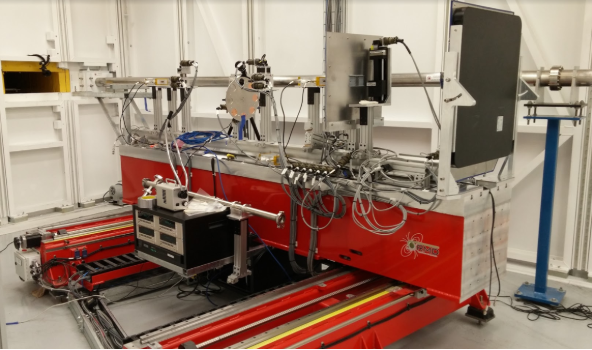
Beamline technical details and performance
| Energy range: | 25-90 keV |
|---|---|
| Flux: | 5x10¹¹ photons/s |
| Beam size, FWHM: | 19 μm V x 2.23 mm H |
| Energy resolution, ΔE/E: | 1.7x10⁻³ |
| Divergence | 700 μrad V |
Pair Distribution Function
The high energy X-rays available at this beamline allows the collection of total scattering data up to high Q values for the generation of high resolution pair distribution functions (PDFs). The PDF gives the distribution of interatomic distances in a material and is an excellent probe of the short and medium range structure in a material. The technique is applicable to crystalline materials with short-range distortions as well as amorphous solids and liquids. Data are usually collected using X-ray energies ranging between 55-70 keV. Qmax values can vary anywhere between 23 to 36 Å-1 depending on the energy and setup. At 60 keV using a powder sample contained in a capillary, the standard configuration, the Qmax will be about 27 Å-1. It is also possible to raise or tilt the detector to expand the Q-range. The use of an area detector allows collection of the high statistic data needed in a short amount of time. Data collection times can range anywhere from 30 seconds to 8 minutes depending on the sample and energy, but are usually between 2 and 4 minutes.
Ambient condition PDF data on pre-loaded capillaries can be collected through our rapid access mail-in program. For amorphous samples or crystalline samples with minimal graininess up to 19 samples can be measured by mail-in. If the sample is grainy and requires the capillary to be spun the limit is 6 samples.
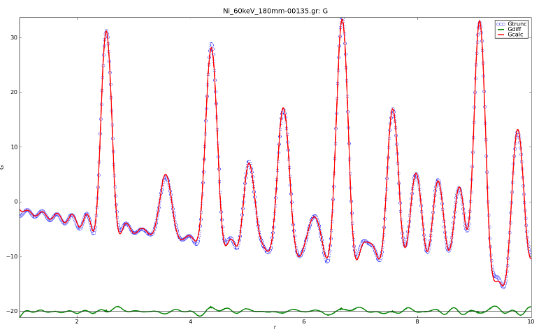
Penetrating Powder Diffraction
One of the primary uses of this beamline is the collection of powder diffraction data on thick solid samples. The high energies available allow penetration of samples up to several millimeters in thickness. Common uses include measurements of whole batteries and solid metal pieces.
Battery experiments can be done with whole, unaltered commercial or lab made cells while cycling the battery to monitor the phase changes inside. The use of an area detector allows the entire diffraction pattern to be collected simultaneous and often in just a few seconds, permitting high time resolution. The battery can also be raster scanned to monitor the behavior at a number of different positions.
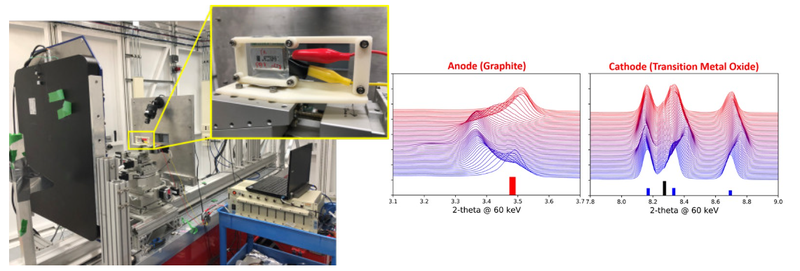
Penetration through solid pieces of metal is also possible using high energy X-rays. This provides bulk structural information, instead of just data on the surface of the metal. Data can be collected very quickly, sometimes in just a few seconds, allowing the phases changes to be monitored during rapid heating or other rapid processes. The use of an area detector provides 2D images which can be used for texture analysis. The beamline is also well suited for tensile measurements and we are in the process of commissioning a stress rig.
It is also possible to measure other solid samples such ceramic pellets. Feel free to contact a beamline scientist to discuss the feasibility of making these kinds of measurements on your samples.
Powder Diffraction in Capillaries
At the Brockhouse Sector, most user requests for "routine" powder X-ray diffraction (PXRD) measurements, e.g., powdered samples in capillaries, will be satisfied by our purpose built high-resolution powder diffraction endstation located at the wiggler low energy (WLE) beamline. But PXRD measurements are also performed on the wiggler high energy (WHE) beamline, because the setup is advantageous and complementary in several situations if high resolution is not essential (the q resolution of WHE data is approximately 4 times larger than WLE for the calibration sample LaB6). Samples can be run on both beamlines under the same proposal, although the sample formats differ slightly between beamlines. Some situations where this beamline is advantageous include:
1) Grainy samples and/or large preferred orientation. The use of an area detector for PXRD captures the full Debye-Scherrer rings, providing an additional level of powder averaging not possible with strip detectors, yielding more reliable peak intensities for these types of samples. It also permits sample measurement without the need for capillary spinning in some cases.
2) Highly absorbing samples containing primarily high Z elements. Although a common strategy to overcome this is to dilute the sample, dilution may not be compatible with all sample types. The higher photon energy range of this beamline provides increased penetration and reduced photo-absorption, for measurements without dilution.
3) In-situ and time resolved experiments. As the whole PXRD pattern can be collected in a few seconds, the WHE setup is excellent for monitoring rapid chemical reactions or making temperature dependent measurements involving a large number of temperature points.
4) Samples with problematic X-ray fluorescence. Samples containing significant amounts of Ga, Ge, As, Se, or Br can show a increased background level at the WLE beamline due to X-ray fluorescence. We have yet to come across an example where this effect was a showstopper. Nevertheless, at the WHE beamline, this effect is suppressed because the incident photon energy is much further away from the absorption edges of these elements.
Powder diffraction data on samples pre-loaded in capillaries can be collected on the high energy beamline using our rapid access mail-in program. For capillaries requiring spinning the limit is 8 samples while up to 20 non-grainy samples can be measured without spinning using our multi-capillary holders.
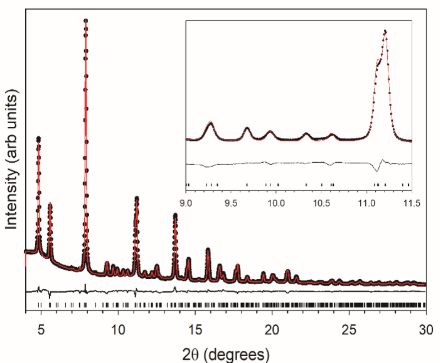
High Pressure Diffraction
Having an intense, focused beam of high energy X-rays allows powder or single crystal diffraction experiments to be conducted at high pressure using a diamond anvil cell (DAC). These are typically done at 35 keV but could be done at any energy within the beamline range. We have a special set which include a pinhole which can reduce the beam size to as small as a 30 µm diameter. We have developed our own software for alignment and centering scans. Users typically bring their own DACs, although there is one available at the beamline. Users should know how to load the DAC as the beamline staff do not know much about its use. A ruby fluorescence system is available for pressure determination. A gas loading system is under development.
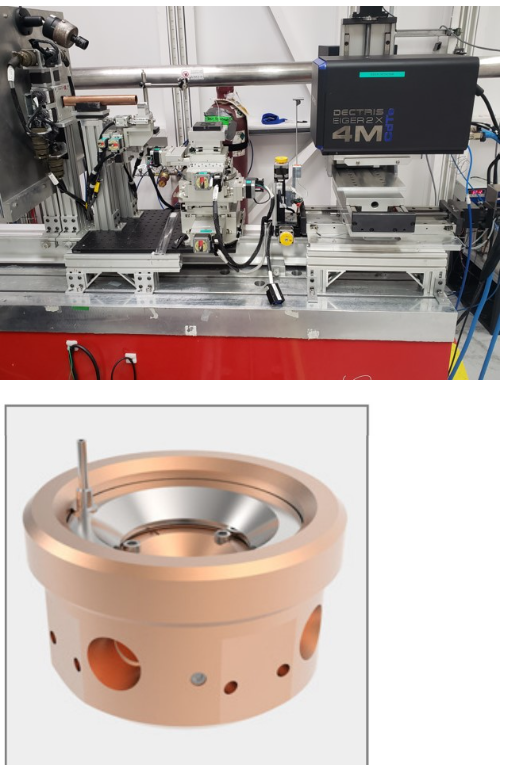
The Bragg-LT(G) Plus diaphragm diamond anvil cell fit with diamond anvil, type IIas, Boehler-Almax design, 16-sided, diameter 3.30 - 85° (X-ray aperture 4θ), culet of 1.20 mm (Pmax 20 GPa), (100)-oriented, ultra-low birefringence, Raman ultra-low fluorescence.
Gas loading system for Diamond Anvil cell: A stand-alone instrument for loading gasses into diaphragm or mechanical diamond anvil cells (DACs) under high pressure.
Training is required to use the gas loading system.
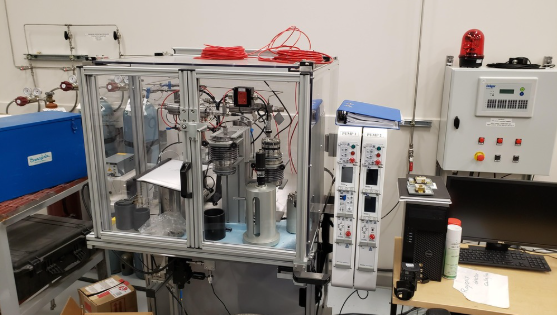
Equipment
Sample Holders:
For powders contained in Kapton or quartz capillaries there are two options for mounting. There is a capillary spinner which holds a magnetic mount containing the capillary. This gives the best data as the capillary can be spun during data collection to get the best powder averaging. For highly grainy samples the use of the spinner is essential. However, in this configuration each samples must be mounted one at a time.
There are also multi-capillary holders which can each hold up to 21 samples. This allows more rapid collection of data as the time spent mounting the samples on the beamline and closing the hutch is reduced. This is a good option if there are a large number of samples to measure and the samples are fine powders which will give smooth diffraction rings. Slightly grainy samples can also work in this configuration and it is possible to jiggle the capillary side to side during data collection to improve the powder averaging a little bit.
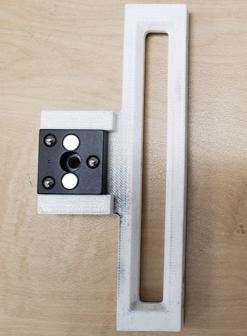
We also have a Kohzu stack with additional motion controls to handle large non-powder samples and special battery holders.
Detectors:
There are two area detectors available at this beamline.
The Varex XRD 4343CT detector has a large active area and a large number of pixels. This allows high resolution powder data to be collected down to small d-spacing values and this is advantageous for PDF measurements as data can be collected to above 50˚ when the detector is moved close to the sample. The detector consists of 2880 × 2880 pixels with dimensions of 150 µm × 150 µm, giving a total active area of 43 × 43 cm. The downsides of this detector is that it has a dark current which must be measured and subtracted, it retains a memory of the previous image which needs to fade away after each measurement, and it is susceptible to saturation. The detector can be vertically offset so that the beam hits near the bottom of the detector, expanding the data range at the cost of only collecting part of the diffraction rings.
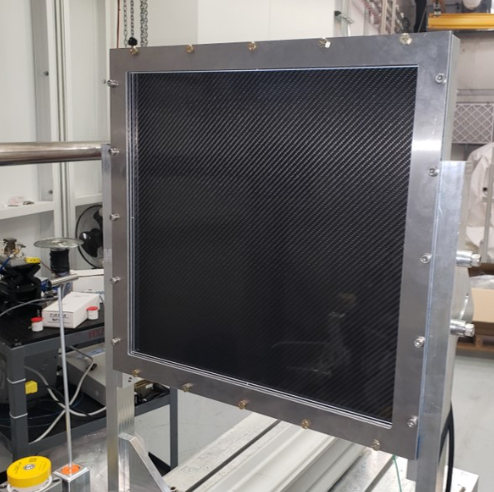
The Eiger2 4M detector has several advantages such as no dark current, no memory, zero pixel spread function, and a high speed which makes saturation nearly impossible. However, the detector is much smaller, having only 2000 × 2000 pixels with dimensions of 75 µm × 75 µm. This limits the range of data that can be collected at a given resolution. The detector also has gaps between the panels. It is mounted on a motorized stage which allows precise positioning and can be moved so that the beam hits near the edge or corner of the detector, allowing a greater range of data to be collected at the cost of only collecting part of the diffraction rings.
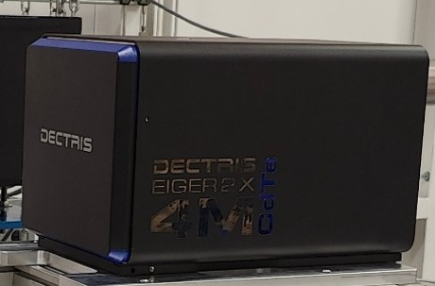
Temperature Controls:
An Oxford Cryostream can cool or heat a capillary to any temperature between 80 and 500 K.
The beamline has a high temperature capillary furnace, which can reach temperatures as high as 1000 ˚C. Samples are contained in quartz capillaries. If more than one or two samples will be run user should purchase their own capillaries in advance. We can also flow non-hazardous gases through the capillaries while heating.
Automatic temperature changes and data collection can be programmed with both machines. If complex temperature sequences are desired, please communicate them to the beamline staff a week or two in advance so we have time to write the macros before your beamtime.
More details about these systems can be found on the sample environments page of this website.
Sample Loading
Measurements of powders are generally done in Kapton capillaries. As absorption is generally low at these energies larger tubes tend to be used, which are easier to load and give stronger signal. Capillaries with a 0.81 mm inner diameter are the standard size used for this beamline. For samples which are more absorbing smaller capillary sizes of 0.63 mm or 0.50 mm can be used. The absorption can be estimated using this website. If the µr is 3 or greater it is recommend to use a smaller capillary. If PDF measurements are being conducted on samples with only light elements 0.9-1.8 mm tubes could be beneficial to get stronger signal.
For a capillary to fit in the WHE sample changer it should be at least 30 mm in total length and it is best if the sample fills at least 12 mm of the capillary. If the spinner will be used the capillary can be short, generally 15-25 mm is a good length. Samples measured with the cyrostream are mounted on the spinner. When loading capillaries it is best to seal the ends with wax or putty. Glue can be used to seal air sensitive samples but be careful not to form a bead at the end which is wider than the capillary or it may not be possible to fit it in the holder. Be sure to grind your samples well before loading! Having samples with large grains will reduce the quality of the data.
It is recommended that users purchase their own capillaries and load the samples prior to arriving at CLS. This helps conserve the beamline supply and makes the measurements more efficient. Capillaries can be purchased here or from other vendors. The beamline also has a supply of capillaries that users can use if it is just for a few samples.